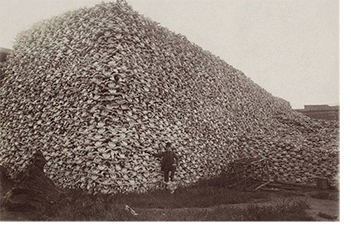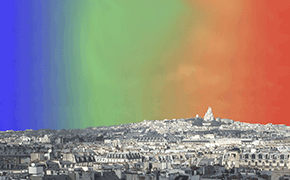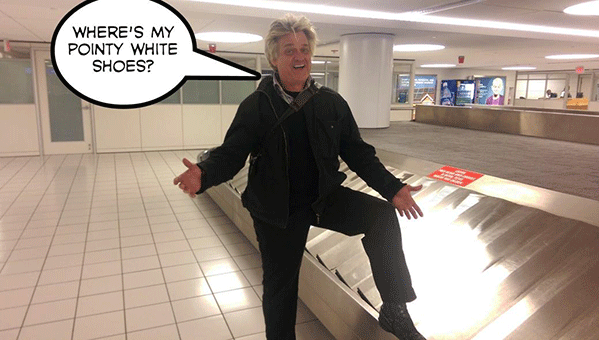Has the apogee of human ‘progress’ coincided with the collapse of civilization?
Is the imminent collapse of global ecosystems accompanied by a comparable collapse of the human spirit?
The immense roster of international artists who are addressing prospects for the future of planet Earth demonstrate that there a manifold answers to these questions. Since they are based more on belief systems than verifiable facts, those at one end of the spectrum might be called “opti-mysticists” and those at the other “pessi-mysticists”. It is yet to be determined which side will win the tug of war between those who cite promising behavioral reforms and beneficial new technologies and those who focus on evidence of mounting system failures.
Paul Crutzen, who was awarded a Nobel prize for research on depletion of ozone layer, coined the term “anthropocene” in 2000 to identify the most distinguishing characteristic of the current era – humans have become most powerful geological force on planet. Human-induced events occurring at the present time loom as the dominant forces on planet Earth. In other words, humanity’s impact on sedimentation, for example, causes more geological shifts than the oceans’ tides or the movement of mountains.
Furthermore, humanity’s impact is not limited to global warming and climate change. Global geological conditions are also being affected by deforestation, acidification of ocean, mass extinction, urbanization, relocations and dislocations of living populations, homogenization of environments.

Today, the U.S. Supreme Court rejected British Petroleum’s claim that it had wrongly been forced to pay hundreds of millions of dollars in claims to businesses whose losses were not caused by the catastrophic Deepwater Horizon explosion in the Gulf of Mexico in 2010, for which they accept responsibility.The justices’ refusal to hear the case was a resounding defeat for the embattled British oil giant which has paid $28 billion in claims and cleanup costs. This defeat came on the heal of a September ruling by a federal judge that found BP grossly negligent in the spill, subjecting the multinational corporation to another $18 billion in civil penalties.
This news coincides with the announcement of an exhibition that represents an artist’s response to this disaster. Brandon Ballengee will be exhibiting “Ghosts of the Gulf”, organized by Amy Lipton, at the Beacon Institute for Rivers and Estuaries. A public reception will take place on Saturday, December 13 from 5 – 7 pm.
Both Natalie Jeremijenko and Brandon Ballengee are artists who apply their extensive training in the sciences to the critical declines in amphibian populations. Jeremineko manifests this mission in a work entitled “Salamander Superhighway”, 2012. The ‘highway’ is actually an enclosed tunnel made of cast iron pipe, a material chosen because it is strong enough to withstand the weight of cars, trucks, and buses. It is laid in an orientation that matches the treacherous path of migrating salamanders as they cross a road. This occurs each year in early spring, on a rainy night, when they emerge from hibernation and assemble to search for the moist, wooded habitats they require for spawning. Because roads fragment forest habitats and interrupt their migration pathways, mortality rates are staggering. Salamander Superhighway not only provides safe passage, it ensures that that salamanders’ trip will be pleasant by piercing the pipe to resemble a summer solstice star map.
Ballengée focuses his artistic and scientific inquiry on the rapid decline of amphibian populations around the world and the occurrence of developmental deformities among amphibians.
Happy World Soil Day!
Today the United Nations launched the International Year of Soils 2015. The formal launch event will occur during the 69th session of the UN General Assembly to coincide with the first official World Soil Day. Concurrent events will take place around the world.
It seems timely that soil is finally receiving worldwide recognition. Cosmic travel and undersea adventures have inspired theme parks, computer games, and Hollywood films, but the dramatic invasions, combats, and reconciliations that transpire under our feet have mostly been ignored. Few current humans pay heed to soil, and they are even less likely to relish soil.
Despite our dependence upon soil for survival, most contemporary humans are oblivious of its elaborate structure, diverse populations, and multi-millennial history. This underground universe exists ‘out of sight’ and ‘out of mind’. No 4-H Club provides ribbons to youngsters who raise excellent breeds of dirt. There is no holiday honoring the founder of soil science. If Muhammad, the Buddha, Jesus, and Moses are revered for saving peoples’ souls, it seems Vasily Vasilievich Dokuchaev (1846 – 1903), the pioneer soil scientist, merits veneration for his role in saving life on Earth.
The following text was drafted for my upcoming book, co-authored by Natalie Jeremijenko, entitled Studio Art Environmental Health Clinic. Comments are welcome:
‘Land’ connotes soil to a farmer, property rights to a lawyer, a commodity to a developer, a voting district to a politician, habitat to an ecologist, a yard to a suburbanite, natural resources to an economist. Yet members of each profession have claimed space under the umbrella term, ‘environmentalism’ even as they adhere to their specialized agendas. What they share is an abiding commitment to the well-being of planet Earth
But what is ‘land’ to an artist?
The long history of Western is imprinted with three land-related narratives. One account tracks those artists who frame a vista and record its visual contents. These artists define ‘land’ as scenery, a source of visual stimulation, a repository of bounteous optical evocations. The second version is occupied by artists who, instead of representing the optical manifestations of land, conscript these visual elements into the service of symbol and metaphor. These artists strip the elements of ‘land’ of their authentic identities and recast them as symbolic representations of phenomena that are not elements of land. Trees, for example, may convey knowledge of good and evil, or communion with the spirit world, or the human brain and spinal cord. The third artistic approach to land is emotionally-charged. Artists who pursue this approach forego compliant observations and the active construction of symbols. They manipulate the components of ‘land’ so that, through such distortions and exaggerations, they register personal passions and sensitivities. In this instance, ‘land’ becomes a vehicle for expressing terror, awe, tranquility, etc.
In the 1960s and 1970s and new movement was launched added a fourth accounting to the art/land legacy. Indeed, it was called ‘Land Art’, a designation that was well-earned even though its practitioners rejected their predecessors’ strategies of interaction, depictions and interpretations; Land artists located their artworks outdoors. Furthermore, they dispensed with neutral mediums, like paint and crayon, to manifest their creative endeavors; instead, they worked with the actual materials of the land. Michael Heizer, for example, used a bulldozer to displace 240,000 tons of earth from the edge of a Nevada mesa, and Robert Smithson laid six thousand tons of black basalt rocks and earth along the shore of the Great Salt Lake to create a peninsula shaped like a counterclockwise spiral.
During the past half-billion years, there have been just five global mass-extinction events. For example, the impact of a comet crash likely extinguished dinosaurs 65 million years ago. Maya Lin is documenting the sixth extinction event which is occurring today. According to the renowned Harvard biologist, E. O. Wilson, 30,000 species are vanishing from Earth each year. They are all eligible for representation in Maya Lin‘s ambitious project, “What is Missing”. This ‘map of memory’ presents species, places, and natural phenomenon that have vanished, or are disappearing.While Lin often features micro and macro views of the earth that are registered through sonar resonance scans and aerial and satellite mapping devices, straightforward photographs are still powerful conveyors of the extent and magnitude of this disturbance. No computer graphics or photo manipulations are required to transmit the devastation of the bisons on this continent in the 1800s.

Asphalt Rundown has acquired unsettling implications that its creator, the artist Robert Smithson, never intended. In 1969, the year this iconic earth work/art action was created, observers, colleagues, and critics generally concurred with the artist’s own explanation – the work made entropy visible. Entropy envisions a final state in which all matter has become inert, all structure has succumbed to disorder, and all processes have ceased. Smithson manifested the ubiquitous, but under acknowledged principle of entropy in terms of the second law of thermodynamics. The law asserts that energy is easier lost than obtained. For this reason, the universe is slowly devolving and will eventually burn out, succumbing to an inert, all encompassing sameness. In this manner, Asphalt Rundown fulfilled one of art’s age-old roles as the visualizer of invisible forces.
Asphalt Rundown was Smithson’s first “flow” work of art. The action took place in a gravel and dirt quarry in Rome that had been abandoned after it was depleted. A large dumptruck loaded with hot asphalt backed up precariously to the edge of the steep incline of the denuded hillside where the former quarry was located. Its bed was raised and hundreds of tons of hot asphalt were dumped down the embankment, forming a massive black swath as it ‘ran down’, yielding to gravity. The sea of the dark ooze slowly made its way down hill, filling in crevices in the eroded, gutted and gullied cliff.
Within the art community, this gesture seemed a heroic enlargement of the spontaneous drips that distinguished Jackson Pollock’s renowned abstract expressionist paintings. The work monumentalized”action paintings”. Asphalt Rundown was honored as the ultimate expressionist mark. Glue Pour and Concrete Pour followed in 1969. In each of Smithson’s pours, the earth served as the artist’s canvas. The glue, asphalt, and concrete were corollaries to paint. The massive pour replaced the paint stroke.
“Without the fog, London wouldn’t be a beautiful city.” These words were written by the French painter, Claude Monet. Between 1899 and 1901, the beauty of his renowned Impressionist paintings was a product of skies that were unnaturally colorful because the city was choked by the smog of the Industrial Revolution. Two environmental scientists, Jacob Baker and John E. Thornes of the University of Birmingham, are rewriting art history by claiming that Monet’s atmospheric images of London were not artistic imaginings; they were the products of accurate observation. In fact, Monet’s impressions seem so accurate that the scientists are examining them as a source of information regarding London air quality during this period. “We believe,” Thornes says, “that we can basically deconstruct the images to work out how much smoke would have to be in the air to create that visibility and those colors in, say, February 1900.”

“Champs D’Ozone”

On Saturday, October 11, the Reverend Billy Talen and his crew landed in St. Louis. They texted their Ferguson friends as they walked from the gate. Ferguson was recently the site of major protests against police who had shot a young African American male who was unarmed. Billy and his friends went to the baggage claim and kept waiting for the old duffel to roll down the conveyor belt. But it didn’t appear. Then they noticed that police and a sniffer-dog were approaching. The police claimed his bag!
What does Billy say about this situation?
“Of course it hadn’t occurred to me, coming from the World Bank protest in Washington, DC, that my little duffel bag on wheels has what looks like a START-UP ACTIVIST KIT: a bullhorn, double AA batteries, elvis hair goop and make-up, “Tree Spiker” the memory by Earth First founder Mike Roselle, and spare clothes and Theo’s seven foot collapsible camera tripod.”
“My 3 Cow Biogas Digester Creates Enough Gas for 6 People” is the headline announcing a new instructional video being produced by Geoff Lawton Lawton, the brawny, charismatic star of the film series he produces to disseminate Permacutlure eco-system enhancement strategies. Good ideas get around.
Continue Reading »
The dialogue that follows was generated by colleagues who accepted my invitation to comment on a statement I had drafted. This text attempted to differentiate ecocentric beauty from anthropocentric beauty. Their questions, comments, and challenges were so insightful, I am sharing them in the hope that they will spark new discussions regarding a fascinating topic that has not earned consensus.
My Statement:
Aesthetics, in my opinion, evolves in tandem with cultural developments. That means the definition of ‘beauty’ can take many forms and refer to many formulations. What is consistent from era to era is that ‘beauty’ embodies a culture’s most esteemed values.
Currently, environmentalism is spurring a radical reconsideration of the relationship between humans and ecosystems. It is revising the anthropocentric definition of beauty that has prevailed for hundreds of years, replacing it with an ecocentric characterization of beauty.
May I propose the following comparisons:
Anthropocentric beauty
– serves the needs and desires of humans
– refers to strategies that assert control over non-human entities, materials, and conditions
– privileges appearance
– approaches nature as an obstacle to overcome, a territory to acquire, a resource to consume, or a condition to control
A formal expression of these values: rigid geometries based on mental constructs
Ecocentric beauty
– promotes responsibility for the welfare of all forms of life, not just humans
– protects and enhances ecosystem functions
– privileges function over appearance
– involves responsive interactions that protect and enhance ecosystems
A formal expression of these values: evolving forms based on interactions between materials, conditions, and forces.



